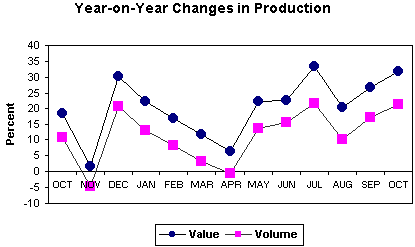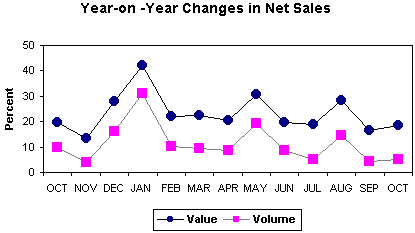- Manufacturing Output Continues to Grow
Manufacturing continued to grow in October 2000 as reflected by the 31.7 percent growth in the value and 21.0 percent in the volume of production, according to the preliminary results of the Monthly Integrated Survey of Selected Industries (MISSI).
Petroleum refineries, food manufacturing and electrical machinery sectors boosted the overall performance of the manufacturing industry due to the increasing demand in both domestic and export markets. The improvement in food manufacturing sector was largely brought about by the increase in the milled and refined sugar subsector. Strong export demand for electrical machinery came with the expansion of manpower contributing to the sector�s positive performance.
- Net Sales Growth Slower than Production
Net sales value and volume in October 2000 rose by 18.4 percent and 5.2 percent, respectively.
Petroleum products and wearing apparel were the top gainers in net sales value and volume. On the other hand, the largest declines in value and volume of net sales were in non-metallic minerals.
Some sectors showed increased production but with a slower rate of increase in net sales which indicate inventory accumulation. This is evident in electrical machinery which gained 31.0 percent in terms of production volume but performed poorly in net sales, posting a decline of 10.2 percent in net sales volume.

- Producer Prices Continue to Strengthen
Producers received 8.8 percent more for their products in October 2000 as the producer price index (PPI) of 141.5 in October 1999 advanced to 154.0 in October 2000. The year-on-year increase was an acceleration from the year-on-year increases of 8.5 percent in September 2000 and 6.6 percent in October 1999.
The gain in the overall PPI was due to the rising prices for petroleum products (48.1%), fabricated metals (25.2%), textile (24.1%), electrical machinery (18.7%), printing and publishing (16.8%).
- Average Capacity Utilization at 84.6%
Average capacity utilization rate for October 2000 for manufacturing was estimated at 84.6 percent, up by 4.2 percentage points over the 80.4 percent a year ago. Eleven out of 16 sectors increased their capacity utilization rate as compared to the same month last year. Petroleum products had the highest capacity utilization rate of 95.0 percent while beverage posted the lowest capacity utilization rate of 67.7 percent.
- Value of Production
In October 2000, the value of production index (VaPI) of 720.9 increased by 31.7 percent from 547.3 in October 1999. Year-on year increases were observed in 11 out of 16 major sectors led by petroleum refineries, which increased by 81.1 percent (See Annex 1-A). Other sectors contributing double-digit growths to the value of production were electrical machinery (55.4%), food manufacturing (21.6%), wearing apparel (21.3%), paper & paper products (29.7%), beverage (21.9%), furniture & fixtures (33.4%) and other manufacturing industries (19.5%).
The sectors that performed badly in terms of value of production were wood & wood products (-24.9%), transport equipment (-11.9%), basic metals (-6.0%), non-metallic mineral products (-1.9%) and tobacco (-0.3%).

- Volume of Production
The volume of production index (VoPI) for total manufacturing increased by 21.0 percent to 182.3 percent from 150.6 of the same month last year. Eleven out of 16 sectors posted year-on-year increases led by petroleum refineries with a 22.3 percent increase. (See Annex 1-B). Other sectors which exhibited double-digit growths over their year-ago performance were food manufacturing (20.9%), electrical machinery (31.0%), wearing apparel (22.3%), paper & paper products (32.0%), beverage (13.4%), furniture & fixtures (33.4%), and other manufacturing industries (27.5%). The increases in the production output of these sectors can be attributed to the high demand of the products from both domestic and export markets. Electrical machinery attributed their positive performance to their increase in labor inputs. On the other hand, the abundance of raw materials for milled and refined sugar subsector contributed to the improvement in the performance of food manufacturing.
Losers in terms of volume of production were textile (-18.2%), wood & wood products (-24.9%), transport equipment (-14.4%), non-metallic mineral products (-4.3%) and basic metals (-0.2%). The decline in the production in these sectors can be attributed either to lack of raw materials, temporary or partial shutdowns in the operation of some establishments due to labor disputes or machinery breakdowns, or decrease in the demand for these products.
- Value of Net Sales
The value of net sales for October 2000 moved up by 18.4 percent compared to the same month last year. Thirteen out of 16 major sectors showed improvements in their value of net sales. The leading sector was petroleum products which rose by 58.7 percent over the same month last year (See Annex 2-A). Other sectors that exhibited double-digit year-on-year growths in their value of net sales were wearing apparel (40.7%), paper & paper products (28.1%), textile (15.6%), furniture & fixtures (67.2%), beverage (14.9%), miscellaneous manufactures (19.8%) and tobacco (25.2%).

On the other hand, sectors with lower values of net sales as compared to the same month last year were non-metallic mineral products (-19.0%), wood & wood products (-10.6%) and transport equipment (-5.2%).
- Volume of Net Sales
The volume of net sales for October 2000 increased by 5.2 percent over the same month last year. Increases were observed in 11 out of 16 sectors led by wearing apparel which expanded by 42.0 percent (See Annex 2-B). Other sectors that exhibited double-digit growths were basic metal (17.7%), paper & paper products (30.3%), furniture & fixtures (67.2%), miscellaneous manufactures (27.9%) and tobacco (26.4%).
On the other hand, decreases were observed in the following sectors: electrical machinery (-10.2%); non-metallic mineral products (-18.0%); wood & wood products (-10.6%); textile (-6.9%); and transport equipment (-7.9%).
- Capacity Utilization
The proportion of responding establishments that operated at full capacity (90%-100%) in October 2000 was 31.9 percent, twice higher than the 14.3 percent posted in October 1999. (See Annex 3-A). About 36.3 percent operated below the 70 percent capacity utilization. This was lower by 14.8 percentage points from 51.1 percent a year ago.
The October 2000 average capacity utilization rate for manufacturing was estimated at 84.6 percent, up by 4.2 percentage points over the 80.4 percent posted in October 1999. Of the 16 sectors, eleven sectors posted higher capacity utilization rates as compared to a year ago. Leading sector was petroleum products, which recorded an average capacity utilization rate of 95.0 percent. Other sectors which registered more than 80 percent capacity utilization rates were electrical machinery (92.0%), miscellaneous manufactures (89.8%), furniture & fixtures (87.9%), paper & paper products (86.6%), chemicals (86.1%), tobacco (84.6%), wearing apparel (84.6%) and food manufacturing (83.1%),
- Response Rate
These results were based on the response of 366 sample establishments, which comprised 70.4 percent of the total number of establishments covered by the survey.


Note: Sectors are ranked according to their contribution to the overall October 2000 growth rate.
r - revised due to updating of data from late responding establishments.

Note: Sectors are ranked according to their contribution to the overall September 2000 growth rate.
r - revised due to updating of data from late responding establishments.

Note: Sectors are ranked according to their contribution to the overall October 2000 growth rate.

Note: Sectors are ranked according to their contribution to the overall October 2000 growth rate.



Source: National Statistics Office
Manila, Philippines
